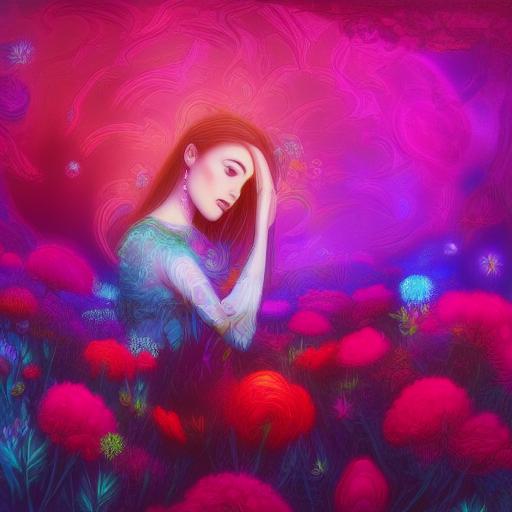How to write this prompt?
Here’s a breakdown of the elements of the prompt and how they influence the generated image:
- Description of the artwork: The prompt provides a clear and detailed description of the artwork, specifying that it is a digital 2D fantasy art portraying a woman surrounded by flowers in a meadow. This sets the overall theme and mood of the artwork, and provides a visual reference for the AI to work with.
- Camera angle: The prompt specifies that an ultra wide-angle camera angle is used, which influences how the image is framed and how much of the environment is visible. This can help create a sense of vastness and immersion, and may influence how the woman and flowers are positioned in the scene.
- Lighting: The prompt specifies that a neon lamp is used to light the scene, creating a vibrant and surreal atmosphere. This can influence the colors used in the image and create a sense of otherworldliness or otherness.
- Color scheme: The prompt specifies that shades of purple and pink are used in the artwork, complementing the overall psychedelic vibe. This helps create a cohesive and visually appealing image, and may influence how the flowers are colored and how the woman’s clothing is depicted.
By providing specific details about the artwork, camera angle, lighting, and color scheme, the prompt helps guide the AI to create an image that matches the desired style and mood. In general, a good prompt should be clear, concise, and provide specific details that help guide the AI’s creative process.
What is the significance of using an ultra wide-angle camera angle in photography or art?
An ultra wide-angle camera angle is used to capture a wider field of view and can help create a sense of vastness and immersion in the scene. It can also be used to exaggerate perspective and create a more dynamic composition.
How to create a neon lighting effect in digital artwork?
To create a neon lighting effect in digital artwork, you can use a combination of bright, saturated colors and layering techniques to simulate the glow of neon lights. You can also use brushes or overlays to add light streaks or glows to specific areas of the image.
Why is color scheme important in art and design?
Color scheme is important in art and design because it can influence the overall mood and emotional response of the viewer. Different colors can evoke different emotions and associations, and choosing the right color scheme can help create a cohesive and visually appealing image. Color theory and psychology are often studied and applied in art and design to help guide color choices.
What are the best tools and platforms for creating AI-generated art?
There are many different tools and platforms available for creating AI-generated art. Some of the most popular options include:
- RunwayML: RunwayML is a cloud-based platform that offers a variety of AI models and tools for creating and experimenting with AI-generated art. It supports a wide range of artistic styles and techniques, and can be used with popular design software like Adobe Photoshop and Illustrator.
- DeepDream: DeepDream is an open-source software developed by Google that uses artificial neural networks to generate abstract and surreal images. It can be used as a standalone program or integrated into other applications.
- Artbreeder: Artbreeder is an online platform that allows users to combine and evolve different images using AI. It can be used to create a variety of different styles and techniques, including portraits, landscapes, and abstract art.
- NVIDIA GauGAN: NVIDIA GauGAN is a AI-powered tool that allows users to create photorealistic landscapes and scenes using simple sketches or annotations. It uses a deep neural network to generate realistic textures and lighting effects.
Are there any limitations or challenges associated with AI art generation?
While AI art generation offers many exciting possibilities, there are also several limitations and challenges that artists and designers should be aware of. Some of the most significant include:
- Lack of control: While AI-generated art can produce surprising and unique results, it can also be difficult to predict or control the output. Artists may need to experiment with different models and techniques to achieve the desired results.
- Intellectual property issues: AI-generated art raises questions around intellectual property and ownership, as the role of the artist and the machine becomes blurred. There is currently no clear legal framework for protecting AI-generated works.
- Data bias: AI models are only as good as the data they are trained on, and biases in the data can lead to biased or inaccurate results. Artists and designers need to be aware of these biases and work to minimize them in their work.
- Ethical concerns: As AI-generated art becomes more advanced, there are also ethical concerns around the role of machines in creative work and the potential displacement of human artists. It is important to consider the ethical implications of AI-generated art and work to address them proactively.
Visual Paradigm Online is a powerful design tool that enables users to seamlessly integrate AI-generated art into their graphic designs, resulting in visually stunning and engaging graphics with just a few clicks. With its user-friendly interface and an extensive collection of design templates and assets, Visual Paradigm Online offers a convenient and effortless way to experiment with various styles and layouts until you achieve the perfect combination for your project.


